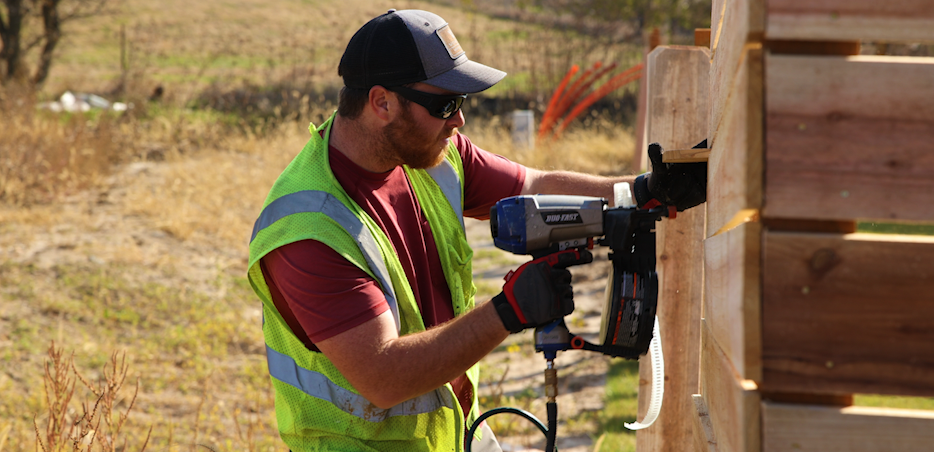4 Steps to Winterize Your Wood Fence

Mother Nature tends to be erratic in the Midwest. Summer sometimes is blisteringly hot—this year was a doozy—while in other instances the mid-year season feels like extended springtime. Likewise, one can never really predict what winter has in store. In the coming months, Cedar Rapids might experience a slightly cooler version of autumn; on the other hand, the state of Iowa could endure months of heavy snow, freezing rain, and icy coating on our homes and outdoor fixtures. If a vicious winter’s indeed on its way, your wood fence will be among the installations threatened by winter damage.
Some winter-related fence damages are instantaneous (e.g., panels shattered by overhanging tree branches) while others produce long-term effects. Some damages actually stem from events before temperatures change. For this reason, it’s important to winterize your wood fence in Cedar Rapids. Unlike vinyl and chain link, wood is highly susceptible to winter-related damages and thus requires beforehand preparations. In this article, we’ll cover 4 steps to winterize your wood fence.
1. Stain Your Wood Fence Before Winter
One of the long-term negative effects Mother Nature tends to have on wood fencing is cracks, splits, and rot. Drive by any neighborhood in spring/summer and you’re bound to notice at least one that’s been affected by this phenomenon. But what causes it? The answer derives from the simple fact that wood—unlike metal and PVC—is an absorbent material. Whenever it rains throughout the year, your fence soaks up and contains precipitation. There it remains trapped until winter, at which point the water solidifies into ice, expanding within the wooden strata and thereby pushing it apart. (This effect can also occur if your fence is exposed to sprinkler overspray.)
In short: it’s best to seal your fence against water absorption, and the best way to accomplish this is with staining. Generally speaking, a fence should be stained every 3-5 years. If yours is due for another coating, apply it now—during autumn—before the temperature plummets to below freezing. Don’t forget: if your un-stained fence becomes covered with snow and ice, the precipitation will turn to water when spring arrives, becoming absorbed into the wood and starting the phenomenon all over again.
2. Remove dangerous objects near your fence
The environment as a whole is subject to winter’s wrath. Take, for example, tree branches hanging above your fence. In the midst of a blizzard, the branches can become weighed down by snow and eventually break—the whole collapsing upon your fence, potentially damaging a few panels. When facing this situation, consider cutting branches. We likewise recommend removing freestanding objects that might collapse upon your fence as the snow accumulates. Also: clean out debris from between the fence posts such as twigs, as clutter prevents melting snow and ice from completely running off your fence.

3. Make fence repairs before winter hits
If your fence has pre-existing damage—cracked posts, split rails, etc.—make pre-winter repairs if possible. (Even staining can’t do much when parts of your fence have gaping holes that beckon precipitation and absorption.) If you’re not comfortable making DIY repairs, contact a local fence contractor in Cedar Rapids. American Fence Company, for example, trains all its employees in maintenance. We can mend fences of all kinds and styles, even those we didn’t install ourselves.
4. Keep your wood fence clean throughout winter
Winterizing a wood fence continues as winter’s underway. When you have a chance after each snowstorm, clean your fence to the best of your ability. Use a soft broom to dust snow off the panels. Clear out snowbanks from around the posts—so that the accumulating pressure and weight doesn’t bend posts and thus alter the integrity of your fence. Also take care to ensure your fence is not exposed to salt, as this substance—designed to corrode and melt snow—can also lead to discoloration and additional damage.
What happens in the event of a blizzard?
Of course, nature has moments of being exceptionally troublesome; in winter, this means blizzards. Faced with breakneck winds and excessive snow, no amount of winterization promises the safety of your wood fence. So while you’re making seasonal preparations, it helps to research your local fence companies in Cedar Rapids—and get an idea of whom you’ll give your business in the event that your fence ends up dilapidated. The ideal contractor has years of experience, works from a comprehensive inventory, and employs industry professionals learned in the fields of fence repair and maintenance.
American Fence Company of Cedar Rapids is your optimum choice. Having operated in the Midwest since the 1960s, we’ve honed the best practices for fence installation and repair. We also maintain the region’s largest materials inventory, a collective whole encompassing more than eighteen acres. Whether you need new rails, studier posts, or a new fence entirely, our team of professionals can help you. Contact us below for more information.
Have a DIY job but need some wood fence parts?
